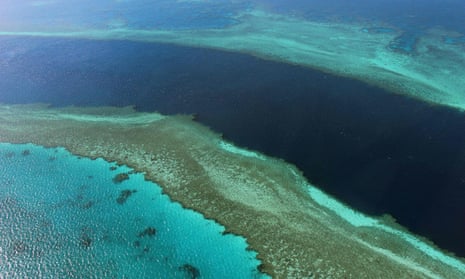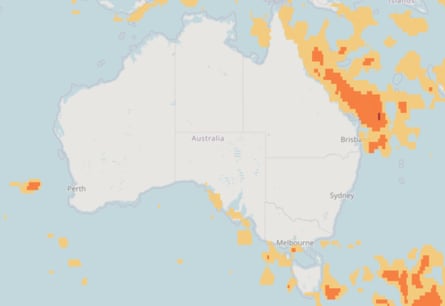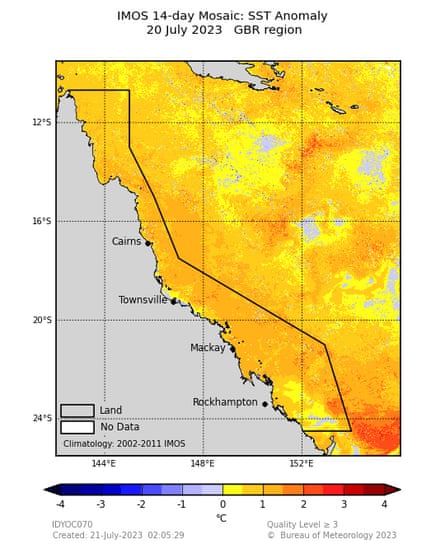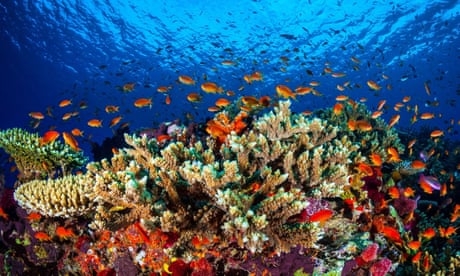
Experts fear for health of corals and other marine life as about 1m sq km of ocean experience prolonged elevated temperatures.
Sat 22 Jul 2023 07.05 AEST
First published on Sat 22 Jul 2023 01.00 AESTSatellite data managed by the US National Atmospheric and Oceanic Administration (NOAA) shows the heatwave started to emerge at the end of June.
About 1m sq km of ocean north-east of the continent are now under heatwave conditions, the data shows.
Experts said the heatwave could increase the risk of coral disease and would probably affect fish populations that would need to work harder to find food under warmer conditions.

The Bureau of Meteorology briefed the Great Barrier Reef Marine Park Authority (GBRMPA) about the raised ocean temperatures on Friday.
A marine heatwave happens when temperatures over an area are in the hottest 10% ever recorded for that time of year and then stay there for at least five days. The NOAA data goes back to 1981.
Experts said the impacts of marine heatwaves in the winter are less dramatic than in summer, when they can damage or kill corals and underwater forests of kelp and seagrass.
Dr Alex Sen Gupta, an associate professor at the UNSW Climate Change Research Centre and marine heatwave expert, said: “If you look globally, we’re seeing more marine heatwaves now than we have ever seen before.
“It’s exceptional at the moment. It’s definitely warm in the [water] north-east [of Australia]. There’s bound to be impacts to animals and plants because of these warmer temperatures.”
Dr Jessica Stella, the assistant director of reef health at GBRMPA, said there was still an element of the unknown about the effects of a heatwave in winter, when overall temperatures are cooler than in the summer.
While there was no risk of corals bleaching in this heatwave, there were concerns it could increase outbreaks of coral disease in the coming months.
“Usually a warmer temperature would mean an increase in disease in corals. In winter disease pathogens usually become more dormant. If [temperatures] don’t cool enough, the pathogens can remain virulent and we could see an uptick in coral disease.”
Prof Jodie Rummer, a marine biologist and fish expert at James Cook University, said marine heatwaves raised the metabolic rate of fish.
“So if everything needs more food, that puts a strain on the whole ecosystem,” she said.
Dr Grant Smith, an oceanographer and researcher at the Bureau of Meteorology, said temperatures were more than 1C above average for this time of year over large portions of the Great Barrier Reef and the Coral Sea.
Temperatures for June over the reef were the 12th highest on record for that month. The outlook over the coming months was for sea surface temperatures over the reef to remain above average until the end of the current forecast period – December.

Experts said if the reef’s waters are already warmer than usual as they enter summer, this would mean less additional heating was needed to stress corals enough for them to bleach – a stress reaction that weakens the animals and can be deadly if temperatures keep rising.
Large parts of the northern hemisphere have been gripped by summer heatwaves on land and in the ocean.
That has come as the World Meteorological Organization and NOAA have declared an El Niño climate pattern that can push up global temperatures.
The Bureau of Meteorology has stopped short of declaring an El Niño, saying the atmosphere has yet to react to the raised sea surface temperatures in the equatorial Pacific.
El Niños increase the risk of coral bleaching and Stella said the prospect of the system emerging was a worry.
“We are very concerned and are planning for the worst and hoping for the best,” she said.
Dr Stuart Corney, an oceanographer at the Institute for Marine and Antarctic Studies at the University of Tasmania, said marine heatwaves can emerge at any time of the year, but generally impacts were less severe in winter.
Around Australia, research has shown marine heatwaves are becoming more frequent and are lasting longer because of climate change, Corney said.
Richard Leck, head of oceans at WWF Australia, said Australians were right to be concerned about “what’s coming our way this summer”.

No comments:
Post a Comment